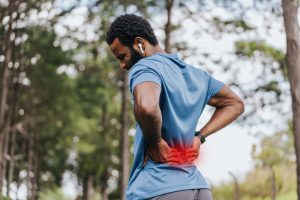Collapsed Disc
A collapsed spinal disc is a spinal disc that has lost its normal height due to the deterioration of its fibrous outer wall. While this degradation can be related to traumatic injury, it is more frequently a result of wear due to the natural aging process. Diminished disc height is most common within the cervical (upper) and lumbar (lower) regions of the spine, where the vertebrae bear significant body weight and are subjected to a wide range of stress-inducing motion. A collapsed disc does not necessarily produce symptoms, but if reduced disc height leads to compression of a nerve root of the spinal cord, pain, tingling, numbness, or muscle weakness can occur.
Anatomy of a Collapsed Disc
The discs are natural shock absorbers between the vertebrae in the spinal column. Discs have two main components, a tougher outer layer, and a gelatinous core. When axial loading pressure occurs along the spinal column, the core of the disc squeezes outward against the outer layer of the disc. The elasticity of the outer wall pushes the core back into position, reestablishing the height and shape of the disc. Through the years as a person ages, the normal daily activity causes repeated loading of the disc. Tiny rips may develop in the fibers of the disc wall causing a loss of natural elasticity.
Eventually, the outer disc wall can no longer push the center material back into shape as effectively, which can lead to bulges and a loss of height. The main way a collapsed disc produces pain and other symptoms are by reducing the space available for spinal nerves. Less space means a greater likelihood of nerve compression. In addition, the decreased disc height reduces the ability of the disc to act as a cushion between vertebrae, creating the potential for the bone to rub against bone causing the development of bone spurs. The bone spurs may also irritate or compress nerves in the spinal column as well.
Conservative Treatment
Medications are an extremely common option for treating collapsed discs. Patients may consider over-the-counter medications from their local drugstore, or they may seek a prescription from their physician. Non-steroidal anti-inflammatory drugs, narcotic painkillers, and even antidepressants can all be an effective part of a collapsed disc treatment plan.
Along with medications, patients can also explore other conservative therapies, including:
- Corticosteroid injections
- Heat and/or ice therapy
- Stretching
- Exercise and physical therapy
- Therapeutic massage
- Yoga
However, if conservative methods fail to provide adequate symptom relief, patients may consider discussing their situation with a surgeon. An orthopaedic surgeon or a non-surgeon can suggest a procedure that has the potential to provide notable long-term benefits.
Causes
A collapsed disc occurs when a spinal disc begins to lose height. While there are many contributors to this condition. It is most often related to the natural aging process.
As you age, the discs in your spine lose water content and can get thinner and weaker. The elasticity in the outer layer of the disc begins to wear down, making the disc more susceptible to flattening and expanding. Because discs are responsible for spacing and supporting the vertebrae, a collapsed disc can lead to increased friction between the vertebrae and potentially painful nerve compression.
Even though age is the main cause of a collapsed disc, there are other risk factors that can contribute to the development of this condition, including:
- Being overweight or obese adds to the pressure on the spinal column
- A sedentary lifestyle
- Poor posture
- Smoking
- Excessive alcohol consumption
- High-impact sports
Symptoms
A collapsed disc can result in symptoms if it causes spinal anatomy to put pressure on the spinal cord or a nerve root. These symptoms can be experienced both locally and radiating along the length of the affected nerve. Specific symptoms include:
- Pain
- Weakness
- Tingling
- Numbness
Surgery
At one point, surgical treatment always involved open neck or open back surgery, such as traditional laminectomy, discectomy, or spinal fusion. However, minimally invasive procedures are now available, and some patients may turn to these techniques as an effective alternative. Typically, minimally invasive surgeries have shorter recovery times and lower complication rates and are performed on an outpatient basis. These factors make them attractive options, although patients must meet certain criteria to be selected as a candidate.
At BEST Health System, we can help you determine which collapsed disc treatments would be best for your specific situation.
Reach Out to BEST Health System Today
If you have experienced any of these symptoms or recieved a diagnosis and need treatment, BEST can help. Take the first step towards relief today.
Related Articles
Possible Causes of a Collapsed Disc
Understanding Collapsed Discs A collapsed disc occurs when a spinal disc begins to lose height. While this condition has many contributors, it is most often […]
Five Alternatives to Collapsed Disc Surgery
Understanding Collapsed Discs A collapsed disc is a condition where one of the spinal discs that cushion the vertebrae begins to lose height. This is […]
Uncommon Causes of a Collapsed Disc
Understanding Collapsed Discs A collapsed disc occurs when one of the spinal discs loses its normal height. The discs serve as shock absorbers for the […]
Treating a Collapsed Disc as an Athlete
Understanding the Cause of Collapsed Discs The spinal discs serve as the spine’s shock absorbers, helping to cushion the other elements of the spine during […]
Four Collapsed Disc Symptoms You Shouldn't Ignore
Understanding Collapsed Discs A collapsed disc, which may also known as a herniated or bulging disc depending on the extent of disc damage, is a […]
Does Degenerative Spine Disease Cause a Collapsed Disc?
What is a Collapsed Disc? “Collapsed disc” is an informal term that is sometimes used to refer to a spinal disc that has lost some […]
Maintaining a Healthy Spine to Prevent a Collapsed Disc
What is a Collapsed Disc? A collapsed disc is a spinal condition in which a spinal disc becomes damaged and loses some of its height. […]
Conditions That Can Cause a Collapsed Disc
Understanding Collapsed Discs A collapsed disc describes a condition in which one of the spinal discs loses its normal height. This can cause a nearby […]
Spinal Conditions that Cause a Collapsed Disc
Overview of Spinal Discs A disc is a pad or structure that functions as a stabilizer for the spine. When the disc loses its ability […]
Three Tips to Improve Collapsed Disc Treatment
Living with a Collapsed Disc For many patients, collapsed disc treatment begins conservatively in an attempt to relieve the symptoms of this condition without having […]
Most Common Causes of Degenerative Joint Disease
Degenerative Joint Disease Overview Degenerative joint disease (osteoarthritis) is a degenerative condition that can impact the cushioning cartilage that coats the facet joints, or the […]
Understanding a Collapsed Disc
Collapsed Disc Overview Collapsed disc treatment generally involves a treatment plan consisting of conservative, nonsurgical treatments. Physical therapy, pain medications, hot/cold therapy, massage, chiropractics, exercise, […]











